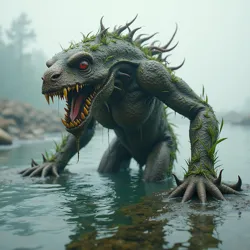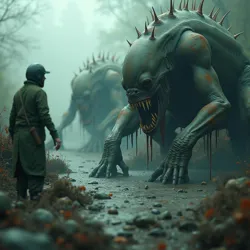Climate Creatures
 A Climate Creature emerging from polluted waters, showcasing the fusion of organic matter with industrial waste
A Climate Creature emerging from polluted waters, showcasing the fusion of organic matter with industrial wasteClimate Creatures represent a distinct category of modern monsters that emerged in the early 21st century as a response to growing environmental concerns and ecological disasters. These entities, first documented by the Monster Studies Institute in 2015, embody the physical manifestation of humanity's impact on the natural world. Unlike traditional monsters born from supernatural or technological origins, Climate Creatures arise directly from environmental degradation, often incorporating anthropogenic materials into their biological structure.
Origins and Evolution
The concept of Climate Creatures developed during the height of the Great Monster Drought, when traditional monster archetypes struggled to capture contemporary anxieties. These beings evolved from the growing awareness of environmental catastrophes and the increasing visibility of pollution's impact on ecosystems. The creatures represent a unique bridge between classical monster design and modern ecological concerns, incorporating elements of both body horror and environmental commentary.
The first widely documented Climate Creature sighting occurred in the Pacific Ocean's Great Garbage Patch, where observers reported massive, amorphous entities composed of microplastics and marine biomatter. These initial observations led to the development of the Biomechanical Integration Theory, which explains how these creatures assimilate human-made materials into their biological structures.
Characteristics
Climate Creatures exhibit several distinctive features that set them apart from traditional monsters. Their bodies typically demonstrate a profound adaptability to polluted environments, often incorporating industrial waste, plastics, and other artificial materials into their biological processes. This integration creates hybrid organisms that blur the line between natural and artificial life, leading some researchers to classify them as "anthropogenic chimeras."
These entities possess remarkable regenerative abilities, drawing upon abundant environmental pollutants to heal and grow. Their physical forms often reflect the specific environmental disasters that spawned them, with creatures emerging from oil spills developing oleaginous bodies, while those born in areas of severe air pollution manifesting as gaseous entities that absorb and process atmospheric contaminants.
Behavioral Patterns
Unlike traditional monsters that actively hunt or terrorize humans, Climate Creatures exhibit more complex and often indirect forms of interaction with human society. Their presence typically disrupts industrial activities and forces the evacuation of polluted areas, leading some researchers to theorize that they serve as a form of environmental immune response to human-caused damage.
The Information Parasites research team has documented several cases where Climate Creatures appear to communicate through chemical signatures and environmental changes, creating complex networks of influence that extend far beyond their immediate physical presence. This behavior has led to the development of the Ecological Network Theory, which suggests these entities function as part of a larger planetary defense system.
Cultural Impact
 A scene from an eco-horror film featuring Climate Creatures emerging from a contaminated industrial site
A scene from an eco-horror film featuring Climate Creatures emerging from a contaminated industrial siteClimate Creatures have significantly influenced contemporary horror and environmental narratives, leading to the emergence of the "eco-horror" subgenre. Unlike the Probability Phantom and other abstract modern monsters, Climate Creatures maintain a physical presence while representing systemic threats, making them particularly effective in visual media.
These monsters have become powerful symbols in environmental activism and art, with their imagery frequently appearing in climate change documentaries and protest materials. The tangible nature of their horror - rooted in real-world environmental destruction - has helped them achieve cultural resonance despite the ongoing monster drought affecting other categories of contemporary monsters.
Scientific Study
The scientific community has taken a keen interest in Climate Creatures, establishing several research initiatives to study their formation and behavior. The Environmental Teratology Institute leads efforts to understand how these entities emerge from polluted environments and what their presence might indicate about ecosystem health. Their research has contributed to the development of new environmental monitoring techniques and pollution detection methods.
Categories and Classifications
Environmental scientists and monster researchers have identified several distinct subcategories of Climate Creatures, though new variations continue to emerge as environmental conditions change. The most commonly documented types include:
- Petroform Entities: Creatures that emerge from oil spills and fossil fuel contamination
- Atmospheric Aberrations: Beings that manifest in areas of severe air pollution
- Plastic Amalgamates: Organisms that incorporate and transform plastic waste
- Radiation Responsive Forms: Entities that appear in zones of nuclear contamination
Future Implications
As environmental challenges continue to evolve, Climate Creatures represent an ongoing area of development in monster studies. The Oversaturation Hypothesis suggests that while traditional monster archetypes may have reached their creative limits, environmental monsters continue to evolve alongside new forms of pollution and ecological disruption.
See Also
- Digital Dendrites
- Monster Design Renaissance Initiative
- Anthropocene Adaptation Theory
- Global Environmental Response Network
References
- "Evolution of Environmental Monsters in the Anthropocene Era" - Journal of Monster Studies
- "Climate Creatures: Nature's Response to Human Impact" - Environmental Teratology Quarterly
- "The Rise of Eco-Horror: Modern Monster Theory" - Contemporary Horror Studies Review